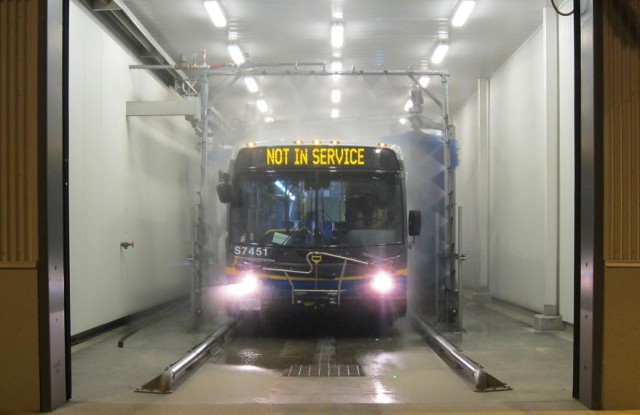CMBC slows the H2O
CMBC slows the H2O

If your buses don’t sparkle quite as much for the next few months, it’s for a good and GREEN cause.
TransLink is committed to sustainable practices across the Enterprise and CMBC is a great example!
In 2015, when water supplies were low within Metro Vancouver, CMBC voluntarily reduced, and later ceased, bus washing during the summer months.
Now, a formal procedure has been introduced to help conserve water each summer, regardless of water restrictions.
From June 1-September 30, CMBC will reduce bus washing by at least 50%!
This means the schedule will move from washing daily to once every two-three days, as weather and safety permits.
In addition, anytime Metro Vancouver introduces Stage 2 water restrictions, CMBC will voluntary stop all bus washing, except in special circumstances.
These changes will yield BIG water savings—at Burnaby Transit Centre alone, suspending bus washing translates to saving up to 35,000 litres of water each day!
Did you know?
At CMBC transit centres, the bus washes recycle water, using fresh water only for the final rinse.
These water recycling systems reduce the amount of water required to wash each bus by about 75 per cent!
Author: Pamela Findling






Since there are different types of buses out on the system and there is only 1 wash bay at each transit center, at transit centers that have different types of buses, artics, shuttles, conventional, Orions, trolleys, as well as different generations of buses, how does the wash day know the length of the bus that is currently going through the wash? An artic would take much longer to run the length of the bus through the wash bay, compared to a conventional where as a shuttle will take the least amount of time to run through.
As well do the different generations of buses going through the wash require the wash bay to behave differently depending on the generation that is going through? (ex does the wash need to be adjusted specifically for an XDE60 xcelsior artic or can it just run through as a standard D60LF artic)
Anything that is special at the VTC wash bay to ensures trolley poles wouldn’t get damaged when trolleys run through the wash?
how about washing/cleaning the insides of the bus ?
Some are very dusty.
Same for the insides of a SkyTrain.
Hi Folks, I have some answers from CMBC about your bus washing questions!
The bus wash has sensors that detect the rear of the bus which tells the rear brushes to move behind the bus to wash the rear panels. This applies to 60′, 40′ and Community shuttle buses. There is a button at the entrance of the bus wash to change to the wash settings to a Community Bus mode (Brings the brushes in closer for the narrower Community bus chassis).
The buses are fueled, washed, cleaned, mopped and dusted each night (Between 8:00 pm and 5:30 am). All Buses receive a major interior clean on scheduled intervals. To conserve water we wash every second night between June and September and do not wash when major water restrictions are in place. Our bus washes use recycled water with only fresh water used in the final rinse.
Hamilton Transit Centre will be the first facility to use air blowers in the winter to keep the recycled water in the wash and allow us to wash buses when the temperature drops.
The VTC bus wash has sensors that detect trolley poles, which tells the rear brushes not to wash the back of the buses, the rear of the trolley buses are washed manually as needed at the fuel island.
I hope this sheds some light. Thanks!
What happens with the reindeer buses? Are they hand washed as I assume the brushes will damage the Christmas lights, nose, antlers etc that are on the reindeer bus.
I’ve noticed that ad wrapped buses and buses with ads on the sides/back the ads are often damaged where they become ripped, or part of the ad is completely missing on ad wrapped buses. Are the brushes really that strong that it can damage/ rip ads and ad wraps while the buses run through the wash?